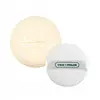What's inside
What's inside
 Key Ingredients
Key Ingredients

 Benefits
Benefits

 Concerns
Concerns

 Ingredients Side-by-side
Ingredients Side-by-side

Silica
AbrasiveZinc Oxide
Cosmetic ColorantBis-Hydroxyethoxypropyl Dimethicone
EmollientAluminum Starch Octenylsuccinate
AbsorbentSynthetic Fluorphlogopite
Triethoxycaprylylsilane
Glyceryl Caprylate
EmollientCaprylyl Glycol
EmollientCI 77492
Cosmetic ColorantWater
Skin ConditioningCentella Asiatica Extract
CleansingTocopherol
AntioxidantNiacinamide
Smoothing1,2-Hexanediol
Skin ConditioningSodium Hyaluronate
HumectantGlycerin
HumectantButylene Glycol
HumectantCitrus Junos Seed Extract
AntioxidantHippophae Rhamnoides Fruit Extract
Skin ConditioningAscorbic Acid
AntioxidantMadecassoside
AntioxidantAsiatic Acid
Skin ConditioningAsiaticoside
AntioxidantPropolis Extract
Skin ConditioningMadecassic Acid
Skin ConditioningSilica, Zinc Oxide, Bis-Hydroxyethoxypropyl Dimethicone, Aluminum Starch Octenylsuccinate, Synthetic Fluorphlogopite, Triethoxycaprylylsilane, Glyceryl Caprylate, Caprylyl Glycol, CI 77492, Water, Centella Asiatica Extract, Tocopherol, Niacinamide, 1,2-Hexanediol, Sodium Hyaluronate, Glycerin, Butylene Glycol, Citrus Junos Seed Extract, Hippophae Rhamnoides Fruit Extract, Ascorbic Acid, Madecassoside, Asiatic Acid, Asiaticoside, Propolis Extract, Madecassic Acid
Silica
AbrasiveDimethicone/Vinyl Dimethicone Crosspolymer
Skin ConditioningVinyl Dimethicone/Methicone Silsesquioxane Crosspolymer
Dimethicone
EmollientButylene Glycol Dicaprylate/Dicaprate
EmollientWater
Skin ConditioningMica
Cosmetic ColorantAlcohol Denat.
AntimicrobialButylene Glycol
HumectantCalamine
AbsorbentEthylhexylglycerin
Skin Conditioning1,2-Hexanediol
Skin ConditioningDehydroacetic Acid
PreservativeAcorus Calamus Root Extract
PerfumingSalicylic Acid
MaskingPropanediol
SolventCentella Asiatica Flower/Leaf/Stem Extract
Skin ConditioningTocopherol
AntioxidantDisodium EDTA
Sodium Hyaluronate
HumectantHydrolyzed Hyaluronic Acid
HumectantSodium Hyaluronate Crosspolymer
HumectantHyaluronic Acid
HumectantSodium Acetylated Hyaluronate
HumectantSilica, Dimethicone/Vinyl Dimethicone Crosspolymer, Vinyl Dimethicone/Methicone Silsesquioxane Crosspolymer, Dimethicone, Butylene Glycol Dicaprylate/Dicaprate, Water, Mica, Alcohol Denat., Butylene Glycol, Calamine, Ethylhexylglycerin, 1,2-Hexanediol, Dehydroacetic Acid, Acorus Calamus Root Extract, Salicylic Acid, Propanediol, Centella Asiatica Flower/Leaf/Stem Extract, Tocopherol, Disodium EDTA, Sodium Hyaluronate, Hydrolyzed Hyaluronic Acid, Sodium Hyaluronate Crosspolymer, Hyaluronic Acid, Sodium Acetylated Hyaluronate
 Reviews
Reviews

Ingredients Explained
These ingredients are found in both products.
Ingredients higher up in an ingredient list are typically present in a larger amount.
1,2-Hexanediol is a synthetic liquid and another multi-functional powerhouse.
It is a:
- Humectant, drawing moisture into the skin
- Emollient, helping to soften skin
- Solvent, dispersing and stabilizing formulas
- Preservative booster, enhancing the antimicrobial activity of other preservatives
Butylene Glycol (or BG) is used within cosmetic products for a few different reasons:
Overall, Butylene Glycol is a safe and well-rounded ingredient that works well with other ingredients.
Though this ingredient works well with most skin types, some people with sensitive skin may experience a reaction such as allergic rashes, closed comedones, or itchiness.
Learn more about Butylene GlycolSilica, also known as silicon dioxide, is a naturally occurring mineral. It is used as a fine, spherical, and porous powder in cosmetics.
Though it has exfoliant properties, the function of silica varies depending on the product.
The unique structure of silica enhances the spreadability and adds smoothness, making it a great texture enhancer.
It is also used as an active carrier, emulsifier, and mattifier due to its ability to absorb excess oil.
In some products, tiny microneedles called spicules are made from silica or hydrolyzed sponge. When you rub them in, they lightly polish away dead skin layers and enhance the penetration of active ingredients.
Learn more about SilicaSodium Hyaluronate is hyaluronic acid's salt form. It is commonly derived from the sodium salt of hyaluronic acid.
Like hyaluronic acid, it is great at holding water and acts as a humectant. This makes it a great skin hydrating ingredient.
Sodium Hyaluronate is naturally occurring in our bodies and is mostly found in eye fluid and joints.
These are some other common types of Hyaluronic Acid:
Learn more about Sodium HyaluronateTocopherol (also known as Vitamin E) is a common antioxidant used to help protect the skin from free-radicals and strengthen the skin barrier. It's also fat soluble - this means our skin is great at absorbing it.
Vitamin E also helps keep your natural skin lipids healthy. Your lipid skin barrier naturally consists of lipids, ceramides, and fatty acids. Vitamin E offers extra protection for your skin’s lipid barrier, keeping your skin healthy and nourished.
Another benefit is a bit of UV protection. Vitamin E helps reduce the damage caused by UVB rays. (It should not replace your sunscreen). Combining it with Vitamin C can decrease sunburned cells and hyperpigmentation after UV exposure.
You might have noticed Vitamin E + C often paired together. This is because it is great at stabilizing Vitamin C. Using the two together helps increase the effectiveness of both ingredients.
There are often claims that Vitamin E can reduce/prevent scarring, but these claims haven't been confirmed by scientific research.
Learn more about TocopherolWater. It's the most common cosmetic ingredient of all. You'll usually see it at the top of ingredient lists, meaning that it makes up the largest part of the product.
So why is it so popular? Water most often acts as a solvent - this means that it helps dissolve other ingredients into the formulation.
You'll also recognize water as that liquid we all need to stay alive. If you see this, drink a glass of water. Stay hydrated!
Learn more about Water